Betelgeuse remains dim. Orion's Betelgeuse is still V magnitude +1.5 or +1.6 as of February 19th, much dimmer than its more typical +0.5. However, it may now be showing subtle signs of rebrightening (by 0.1 magnitude or less) as measured photoelectrically. To the eye, Orion's two shoulder stars still look basically equal. See Is Betelgeuse Approaching a Crossroads?
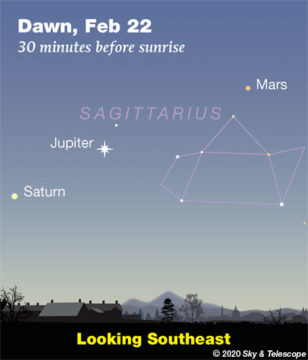
Friday, Feb. 21
• Look high over Venus after dark for the two brightest stars of Aries, lined up almost vertically. And high above Aries, and perhaps a bit left, are the Pleiades.
Venus is a good 40° from the Pleiades right now. But for the next six weeks, watch as they head straight toward each other. On the evening of April 3rd, Venus will shine just inside the cluster's edge.
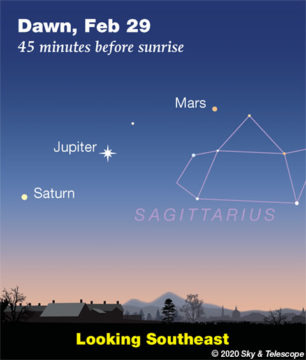
Saturday, Feb. 22
• Have you ever seen Canopus, the second-brightest star after Sirius? It lies almost due south of Sirius by 36°. That's far enough south that it never appears above your horizon unless you're below latitude 37° N (southern Virginia, southern Missouri, central California). And there, you'll need a very flat south horizon. Canopus crosses the south point on the horizon just 21 minutes before Sirius does.
When to look? Canopus is due south when Beta Canis Majoris — Murzim the Announcer, the star
about three finger-widths to the right of Sirius — is at its highest due south over your
landscape. That's about 7 or 8 p.m. now, depending on how far east or west you live in your time zone. Look straight down from Murzim then.
• Some telescopic deep-sky objects hold secret surprises in or near them. Get out your telescope and sky atlas for a go at Bob King's eight Hidden Gems in Common Deep-Sky Objects now in evening view.

Sunday, Feb. 23
• Walk the stars of the Winter Hexagon, and seek out some of their deep-sky surroundings, with Gary Seronik's Explore the Winter Hexagon Tonight.
• New Moon (exact at 10:32 a.m. EST).
Monday, Feb. 24
• Under the feet of Orion, and to the right of Sirius in early evening now, hides Lepus the Hare. Like Canis Major, this is a constellation with a connect-the-dots that really looks like what it's supposed to be. He's a crouching bunny, with his nose pointing lower right, his faint ears extending up toward Rigel (Orion's western foot), and his body bunched to the left. His brightest two stars, 3rd-magnitude Beta and Alpha Leporis, form the front and back of his neck.
Tuesday, Feb. 25
• In twilight, look far below Venus for the thin crescent Moon. Think photo opportunity.
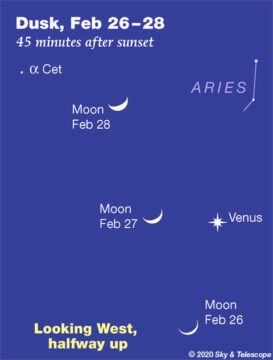
Wednesday, Feb. 26
• The thickening crescent Moon is closer under Venus this evening, as shown here.
Thursday, Feb. 27
• The crescent Moon is 6° or 7° left of Venus during and after twilight, as shown here. How early can you spot them both? You can start trying long before sunset!
Friday, Feb. 28
• After dinnertime at this time of year, five carnivore constellations are rising upright in a row from the northeast to south. They're all seen in profile with their noses pointed up and their feet (if any) to the right. These are Ursa Major the Big Bear in the northeast (with the Big Dipper as its brightest part), Leo the Lion in the east, Hydra the Sea Serpent in the southeast, Canis Minor the Little Dog higher in the south-southeast, and bright Canis Major the Big Dog in the south.
Saturday, Feb. 29
• As the stars come out, look above the Moon to see how early you can detect the Pleiades. They're about 13° over the Moon: a fist at arm's length or a little more.
Easier to spot, and helping to guide you, will be orange Aldebaran a similar distance to the Pleiades' left.
Want to become a better astronomer? Learn your way around the constellations. They're the key to locating everything fainter and deeper to hunt with binoculars or a telescope.
This is an outdoor nature hobby. For an easy-to-use constellation guide covering the whole evening sky, use the big monthly map in the center of each issue of Sky & Telescope, the essential guide to astronomy.
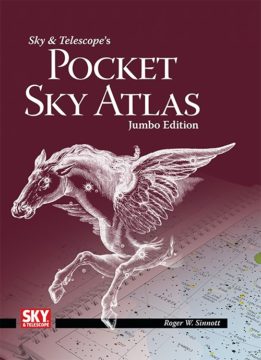
Once you get a telescope, to put it to good use you'll need a detailed, large-scale sky atlas (set of charts). The basic standard is the Pocket Sky Atlas (in either the original or Jumbo Edition), which shows stars to magnitude 7.6.
Next up is the larger and deeper Sky Atlas 2000.0, plotting stars to magnitude 8.5; nearly three times as many. The next up, once you know your way around, are the even larger Interstellarum atlas (stars to magnitude 9.5) and Uranometria 2000.0 (stars to magnitude 9.75). And read how to use sky charts with a telescope.
You'll also want a good deep-sky guidebook, such as Sue French's Deep-Sky Wonders collection (which includes its own charts), Sky Atlas 2000.0 Companion by Strong and Sinnott, or the bigger Night Sky Observer's Guide by Kepple and Sanner.
Can a computerized telescope replace charts? Not for beginners, I don't think, and not on mounts and tripods that are less than top-quality mechanically (meaning heavy and expensive). And as Terence Dickinson and Alan Dyer say in their Backyard Astronomer's Guide, "A full appreciation of the universe cannot come without developing the skills to find things in the sky and understanding how the sky works. This knowledge comes only by spending time under the stars with star maps in hand."
This Week's Planet Roundup
Mercury is hidden from sight in the skirts of the Sun.
Venus (magnitude –4.2, in Pisces) is the big, bright "Evening Star" shining in the west during and after twilight. Look to its right or lower right as the stars come out for the Great Square of Pegasus, sinking down on one corner. Venus doesn't set now until two hours or more after the end of twilight.
In a telescope, Venus is 18 arcseconds in diameter and gibbous (65% sunlit). It will enlarge in size and wane in phase for the rest of the winter and much of the spring — passing through dichotomy (half-lit phase) in late March before becoming a dramatic thin crescent in May.
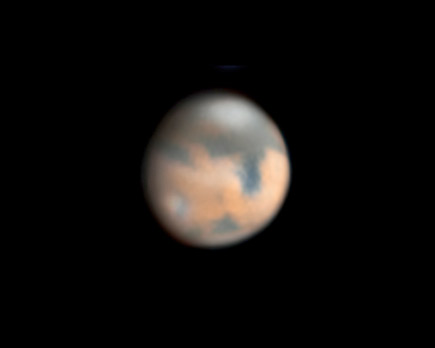
Mars (magnitude +1.2, above the Sagittarius Teapot) glows in the southeast before and during early dawn. Don't confuse it with Antares, shining with the same color and brightness some 25° to Mars's upper right. Mars is still a tiny 5 arcseconds in diameter. But it's on its way to a fine opposition in October, when it grow to 22.6 arcseconds wide.
Mars (magnitude 1.2, above the Sagittarius Teapot) glows in the southeast before and during dawn. It's upper right of bright Jupiter. Compare Mars to Antares, similar in color and brightness, which is far over to its upper right in the south.
Jupiter (magnitude –1.9, in Sagittarius) shines much brighter (and whiter) lower left of Mars left. They're closing in on each other; Mars is 14° from Jupiter on the morning of February 22nd and 11° from it on the 29th.
Saturn (magnitude +0.6, also in Sagittarius) is low in early dawn, 9° lower left of Jupiter, almost a fist at arm's length. Binoculars will help as the sky brightens.
Uranus (magnitude 5.8, in southwestern Aries) is high in the west-southwest right after the end of twilight, hiding in the dark some 10° or 15° above Venus. Finder chart (without Venus).
Neptune is lost in the sunset.
All descriptions that relate to your horizon — including the words up, down, right, and left — are written for the world's mid-northern latitudes. Descriptions that also depend on longitude (mainly Moon positions) are for North America.
Eastern Standard Time (EST) is Universal Time (UT, UTC, GMT, or Z time) minus 5 hours.
![]() Audio sky tour. Out under the evening sky with your earbuds in place, listen to Kelly Beatty's monthly podcast tour of the heavens above. It's free.
Audio sky tour. Out under the evening sky with your earbuds in place, listen to Kelly Beatty's monthly podcast tour of the heavens above. It's free.
 2
2








Comments
Pencil BFB
February 21, 2020 at 1:46 pm
Saw the Crux and Southern Pointer Stars at 1:30 AM on 22 February!
You must be logged in to post a comment.
Rod
February 27, 2020 at 8:27 pm
27-Feb-20, waxing crescent Moon and Venus. I was out observing this celestial event from about 1730-1830 EST. Clear skies, winds from NW and temperature 2C. Quite a lovely view using my 10x50 binoculars and 90-mm refractor telescope. Sunset near 1757 EST and earthshine very obvious on the waxing crescent Moon, especially after 1812 EST and later. [Viewed waxing crescent Moon and Venus near each other in SW-WSW sky tonight after sunset. The waxing crescent Moon and star, Nu Piscium fit into the same FOV at 71x . Starry Night Pro Plus 8 shows about 22' angular separation between the star and earthshine limb of the Moon. Earth rotation apparent in FOV. Starry Night reports this is a red giant star about 58 solar radii size. Sky & Telescope reports for this evening, "Thursday, Feb. 27 • The crescent Moon is 6° or 7° left of Venus during and after twilight, as shown here. How early can you spot them both? You can start trying long before sunset!" I was able to see Venus near 1739 EST, unaided eyes and when I was out at 1730, no problem viewing the waxing crescent Moon. 1812 EST, I could see the star, Nu Piscium near the earthshine lunar limb using the telescope. The eyepiece I used showed all of the waxing crescent Moon with the star. 1821 EST, I could see the Moon and star using 10x50 binoculars. Earthshine lovely in the telescope view as well as binocular view. This was an excellent time to view before sunset and after sunset until 1830 EST. Very lovely sky tonight. As I viewed this evening, a couple of flocks of geese flew by honking. The great outdoors Using the telescope, Venus was a smaller (almost 18.5 arcsecond tonight), nearly half-moon shape with some cloud banding visible near the terminator line along the equator. The waxing crescent Moon much larger angular size (near 30 arcminute) with numerous craters visible along the terminator line, and the star, just a point of light in the eyepiece.]
You must be logged in to post a comment.
You must be logged in to post a comment.